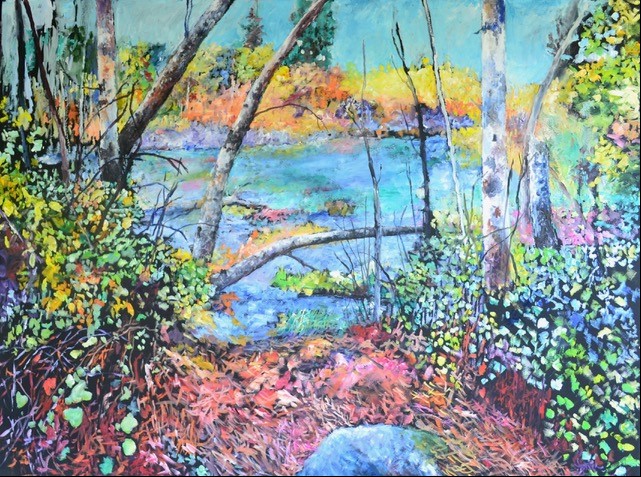Latah Creek by Hangman Golf Course
The local artist LR Montgomery asked us for short descriptions of his paintings of local waters, and we were most pleased to assist. Please visit LR’s current show in Spokane at the Museum of Arts and Culture. His show is up until October 14th, 2018.
Multi-layered streamside vegetation is not only beautiful – it is also essential to protect clean water and wildlife habitat. Preservation of native streamside (riparian) buffers is one of the most important ways to achieve clean water in the Spokane River and its tributaries.
Spokane River near Mission Street Bridge
Large round boulders and cottonwood trees are the Spokane River’s signature. The round boulders remind us that in some areas our aquifer flows into the river, and in some areas, the river flows into the aquifer. Tall, regal cottonwood trees shade and cool the water, and when allowed to fall into the river, provide refugia for our special fish – the redband trout.
Spring Runoff at Spokane River
We often forget that river flow is controlled for reasons other than the health of the river. High flows in the spring remind us of the truly wild past - when our river was a free-flowing, bold river without any dams. In some stretches of the river, there is no flow at all during the summer months – which causes a variety of water quality problems. So let your mind wander when you are able to catch a glimpse of the river’s power in the spring.
Birch Reflections at Slavin
Permanent and seasonal wetlands benefit all of us. Forested wetlands have become increasingly rare. In addition to being beautiful, these habitats are valuable for wildlife habitat and groundwater recharge. Over 120 species of birds inhabit this area. Birch is an ancient and abundant tree – the bark was used for writing or painting stories on by Native American peoples.
A River Runs Through it - Latah at Vinegar Flats
Lower Latah Creek has beautiful, healthy habitat - a stark contrast to the lack of habitat and very poor water quality along most of it’s upper reaches. Image beavers here – helping to hold back water, improving wetland health and diversity. Upper Latah Creek has some of the worst water quality and most degraded habitat in Washington State. Appreciate, protect, restore.
Yellow Grass Island at Latah Creek
In many upstream areas of Latah Creek, the creek has been straightened to improve drainage. This beautiful meandering section reminds us to appreciate wild sections of the creek. We all must learn to appreciate such diversity, and strive to protect what is left, and restore areas that have been harmed.
Pond at Dishman Hills
Forested wetlands and ponds are home to an amazing diversity of wildlife. In this painting, it is easy to imagine a beaver at work – harvesting trees, munching aquatic vegetation. By building dams, beavers enrich our landscape by holding back water, expanding wetlands, recharging groundwater, creating more diversity, and improving water quality.
First Day of September - Latah Creek
Still, quiet, and vegetated – this section of Latah Creek provides abundant insects to feed salmon, which no longer come. Before the dams, huge Chinook Salmon were able to travel all the way up to upper Latah Creek near Tekoa. These provided the Coeur d’Alene people with an abundant food supply. The water isn’t healthy enough for salmon, even if they were able to negotiate the numerous dams. We want the salmon to return.
Iller Creek Spring Runoff
Small creeks, however ephemeral, are works of art. Here, cold fast water carries along a load of wood during a spring flood. Wood will help build stream structure, feed insects, and create refugia and hiding places for our beloved redband trout. The redband is our “sentinel” species, acting as a measure of our river’s aquatic health.
Still Waters of Summer
Some stretches of our river are cold, and some stretches are warm. The stretches where the river recharges the aquifer are called gaining reaches, and are typically too warm for our native fish species. The stretches where the aquifer recharges the river are typically much colder, and these are places where our native fish thrive.
Long Shadows Across the River
Never take our Ponderosa Pine for granted. It is extremely adaptable – and can inhabit soil conditions at both high and low elevations. It is able to thrive in many soil conditions including deep, moist, well-drained, loamy sand, clay loam, rocky, dry, alkaline and salt soils. It has the ability to grow very large, and is one of the most widely distributed tree species in the West.
Spring Flood Water at Little Spokane River
The Little Spokane River brings many of us joy during the hot summer months. It’s upper stretches are abused by lack of buffers, livestock, and other insults. Help us protect this very important tributary of the Spokane River.













